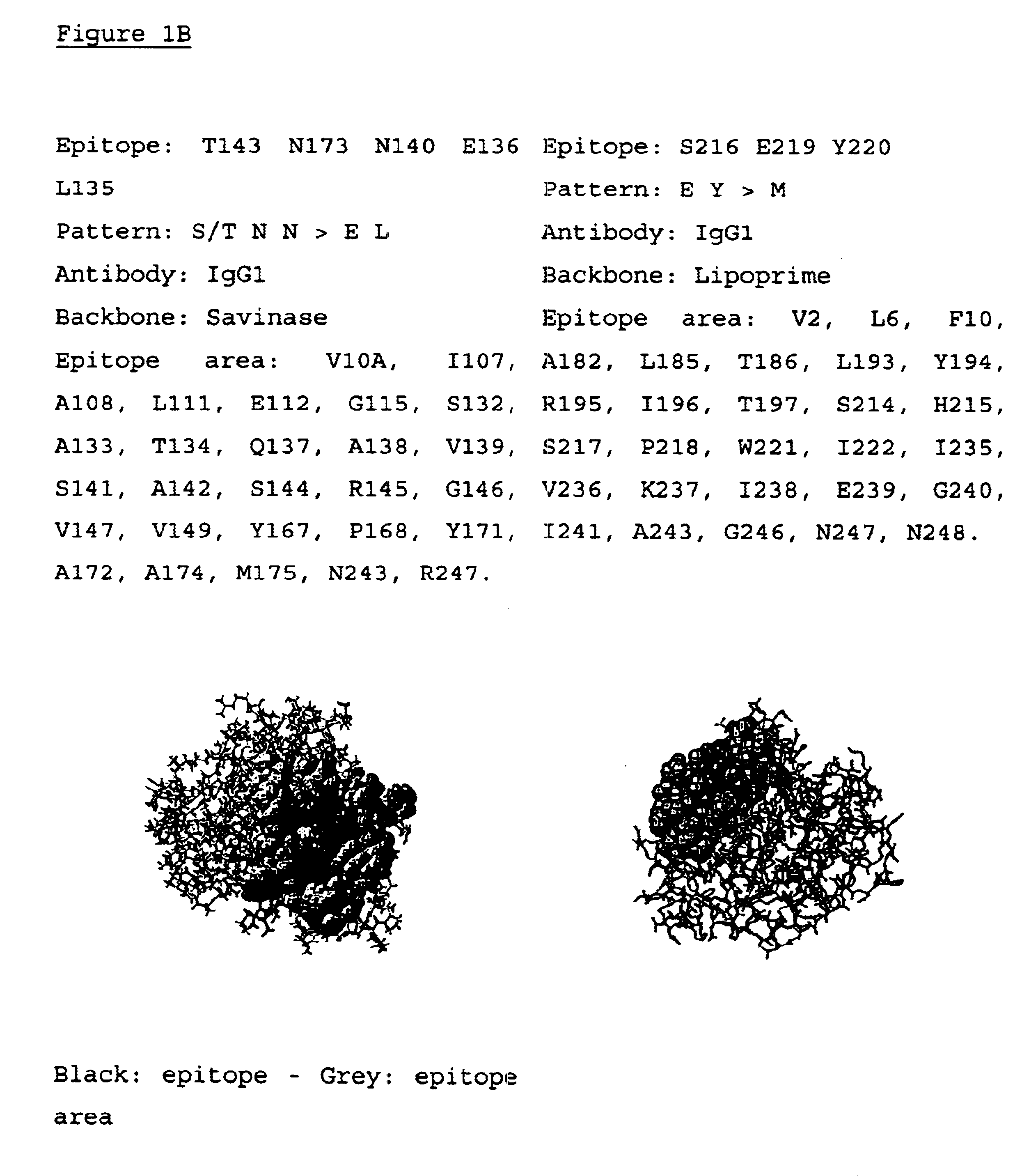Low allergenic protein variants
a protein variant, low allergenic technology, applied in the direction of instruments, peptide/protein ingredients, directed macromolecular evolution, etc., can solve the problems of epitope loss, reduced importance, and trial and error character
- Summary
- Abstract
- Description
- Claims
- Application Information
AI Technical Summary
Problems solved by technology
Method used
Image
Examples
example 1
Epitope Patterns
Screening a random phage display peptide library with IgG antibodies raised against the parent protein revealed the following epitope patterns.
Sequences marked with(*) may exist in the context of a Cys-Cys bridge.
Bold: anchor amino acid
Italic: conservative mutations
example 2
Epitope Mapping Using Phage Display Libraries and 3D Analysis
Identification of Epitope Sequences and Epitope Patterns
High diversity libraries (10.sup.12) of phages expressing random hexa-, nona- or dodecapetides as part of their membrane proteins, were screened for their capacity to bind purified specific rabbit IgG, and purified rat and mouse IgG1 and IgE antibodies. The phage libraries were obtained according to prior art (se WO 92 / 15679 hereby incorporated by reference).
The antibodies were raised in the respective animals by subcutanuous, intradermal or intratracheal injection of relevant proteins (f.e. proteases, lipases, amylases, oxidoreductases) dissolved in phosphate buffered saline (PBS). The respective antibodies were purified from the serum of immunised animals by affinity chromatography using paramagnetic immunobeads (Dynal AS) loaded with pig anti-rabbit IgG, mouse anti-rat IgG1 or IgE, or rat anti-mouse IgG1 or IgE antibodies.
The respective phage libraries were incubat...
example 3
Localization of the Respective Epitopes and Epitope Areas on the 3D-structure of Proteins
Each epitope was assessed on the 3D-structure of the protein of interest, using an appropriate software (f.e. Swiss Pdb Viewer, WebLite Viewer).
In a first step, the identified epitope patterns were fitted with the 3D-structure of the enzymes. A sequence of at least 3 amino acids, defining a specific epitope pattern, was localized on the 3D-structure of the protein. Conservative mutations (e.g. aspartate for glutamate, lysine for arginine, serine for threonine) were considered as one for those patterns for which phage display had evidenced such exchanges to occur. Among the possible sequences provided by the protein structure, only those were retained where the sequence matched a primary sequence, or where it matched a structural sequence of amino acids, where each amino acid was situated within a distance of 5 .ANG. from the next one. Occasionally, the mobility of the amino acid side chains, as ...
PUM
| Property | Measurement | Unit |
|---|---|---|
| Lattice constant | aaaaa | aaaaa |
| Fraction | aaaaa | aaaaa |
| Volume | aaaaa | aaaaa |
Abstract
Description
Claims
Application Information
 Login to View More
Login to View More - R&D
- Intellectual Property
- Life Sciences
- Materials
- Tech Scout
- Unparalleled Data Quality
- Higher Quality Content
- 60% Fewer Hallucinations
Browse by: Latest US Patents, China's latest patents, Technical Efficacy Thesaurus, Application Domain, Technology Topic, Popular Technical Reports.
© 2025 PatSnap. All rights reserved.Legal|Privacy policy|Modern Slavery Act Transparency Statement|Sitemap|About US| Contact US: help@patsnap.com


